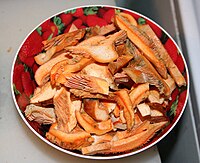Lactarius deliciosus
| Lactarius deliciosus | |
|---|---|

| |
| Scientific classification | |
| Domain: | Eukaryota |
| Kingdom: | Fungi |
| Division: | Basidiomycota |
| Class: | Agaricomycetes |
| Order: | Russulales |
| Family: | Russulaceae |
| Genus: | Lactarius |
| Species: | L. deliciosus
|
| Binomial name | |
| Lactarius deliciosus | |
| Synonyms[1] | |
| Lactarius deliciosus mycorrhizal | |
|---|---|
| Edibility is edible | |
Lactarius deliciosus, commonly known as the delicious milk cap,
Taxonomy
The species was known to
It is commonly known as saffron milk-cap, red pine mushroom, or simply pine mushroom in English. An alternative North American name is orange latex milky.[7] Its Spanish name varies (níscalo, nícalo, robellón...).[8] Its Catalan name is rovelló (pl. rovellons). In the Girona area, it is called a pinetell (in Catalan) because it is collected near wild pine trees; it is typically harvested in October following the late August rains. Both this and L. deterrimus are known as "kanlıca", "çıntar" or "çam melkisi" in Turkey.[9][10] In Romania, it is known as Rascovi and it can be found in the northern regions in autumn season.
Description
Lactarius deliciosus has a carrot-orange cap that is convex to vase shaped, inrolled when young, 4 to 14 centimetres (1+1⁄2 to 5+1⁄2 inches) across, often with darker orange lines in the form of concentric circles. The cap is sticky and viscid when wet, but is often dry. It has crowded decurrent gills and a squat orange stipe that is often hollow, 3 to 8 cm (1 to 3 in) long and 1 to 2 cm (1⁄2 to 1 in) thick. The flesh stains a deep green color when handled.[11] When fresh, it exudes an orange-red latex that does not change color.
The mushroom is similar to L. rubrilacteus, which stains blue, exudes a red latex, and is also edible.[12] It also resembles L. olympianus, which has white latex and tastes unpleasant.[11]
Chemistry
When grown in liquid culture, the mycelium of Lactarius deliciosus produces a mixture of fatty acids and various compounds such as chroman-4-one, anofinic acid, 3-hydroxyacetylindole, ergosterol, and cyclic dipeptides.[13]
Distribution and habitat
L. deliciosus grows under
After
Pine plantations and Siberian pine forests are favourable habitats for this species.
Uses

L. deliciosus is an edible mushroom,[17] but may taste mild or bitter;[11] its misleading epithet, deliciosus ('delicious'), may have been caused by Linnaeus mistaking it for another species.[5] The mushrooms are collected in August to early October, where they are traditionally salted or pickled.[18][19] High consumption of the species may cause urine to discolor to orange or red.[20] At least one field guide holds Lactarius rubrilacteus in higher esteem.[18]
It is widely collected in the
This mushroom is also very popular in Russia.[18]
Further north and east it is a feature of Provençal cuisine.[21] They are also collected in Poland, where they are traditionally served fried in butter, with cream, or marinated. In Cyprus, saffron milk caps are usually grilled on the charcoal and then dressed in olive oil and lemon or bitter orange, they are sauteed with onions, or sometimes stewed with onions, coriander and red wine. In Russian cuisine these mushrooms are traditionally preserved by salting.
In India, the fungus is one of the ten most widely consumed mushrooms by ethnic tribes of Meghalaya.[22]
Culture
A fresco in the Roman town of Herculaneum appears to depict L. deliciosus and is one of the earliest pieces of art to illustrate a fungus.[23][24]
See also
References
- ^ "Lactarius deliciosus (L.) Gray". Index Fungorum. CAB International. Retrieved 2010-07-07.
- ISBN 978-0-89815-169-5.
- ^ (in Latin) Linnaeus, C (1753). Species Plantarum: Tomus II (in Latin). Holmiae. (Laurentii Salvii). p. 1172.
- ISBN 0-304-52257-0.
- ^ ISBN 0-15-683800-1p. 185.
- ^ Gray, SF (1821). The Natural Arrangement of British Plants. London. p. 624.
- ISBN 0-8117-2641-X.
- ISBN 0-14-046230-9.
- ^ a b Solak MH, Isiloglu M, Gücin F, Gökler I (1999). "Macrofungi of Izmir Province" (PDF). Turkish Journal of Botany. 23: 383–90. Archived from the original (PDF) on 2008-12-17. Retrieved 2008-02-16.
- ^ a b Gezer K. (2000). "Contributions to the Macrofungi Flora of Antalya Province" (PDF). Turkish Journal of Botany. 24: 293–98. Archived from the original (PDF) on 2017-08-11. Retrieved 2008-02-16.
- ^ OCLC 797915861.
- ISBN 978-0-7627-3109-1.
- .
- PMID 36913576.
- .
- PMID 18333506.
- ISBN 978-0-7627-3109-1.
- ^ JSTOR 3759750.
- ISBN 9780898153880.
- PMID 13072328.
- ISBN 1-85793-632-9.
- PMID 25130907.
- ^ Ramsbottom J. (1953). Mushrooms & Toadstools. Collins.
- ISBN 978-9963-7380-0-7.
Cited texts
- Bessette AR, Bessette A, Harris DM (2009). Milk Mushrooms of North America: A Field Guide to the Genus Lactarius. Syracuse: Syracuse University Press. pp. 177–78. ISBN 978-0-8156-3229-0.
- Hesler LR, Smith AH (1979). North American Species of Lactarius. Michigan: The University of Michigan Press. ISBN 0-472-08440-2.
External links
 Media related to Lactarius deliciosus at Wikimedia Commons
Media related to Lactarius deliciosus at Wikimedia Commons
